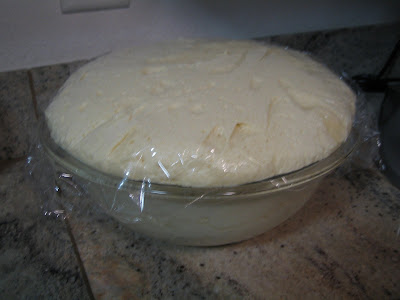
The other ingredients in the picture are, kind of from left to right: butter, cream, parsley, nutmeg, bay leaf, vinegar, panko, curry powder, horseradish, Emmentaler cheese, and shallot.
The first step was to prepare the cauliflower. I did this by removing the leaves and cutting away the florets. The cores were set aside for use in this dish, and the florets were chopped into smallish pieces:

There is kind of an odd skin on the core, so I peeled that off and chopped the remaining core before placing it in the food processor:

I let the processor run for a solid minute to puree the core, only to find myself a little short of the required 1 cup. In went a few florets, and a few seconds later I was all set:

That's the end of the prep work associated with this dish. From this point on, it's pretty straightforward. I blanched the florets in a pot of water, salt, and vinegar (the vinegar keeps the florets white).
I added butter and shallot to a saucepan and let that cook for a minute or two to soften the shallot up:

I added to that some seasonings, the bay leaf, thyme and parsley. I added to that the cauliflower puree, and to that I added a little under a cup of water. That all turned into a milky white sauce that didn't really smell that good:

After that had cooked down a little bit, I added the cream and simmered the mixture for two minutes. I took the sauce off the heat and fished out all of the items that don't belong in a sauce.

The sauce made its way over to the blender and received a few gratings of curry powder. It looks kind of like egg nog, but trust me, it's not:

Once the mixture had cooled a little bit, I added the horseradish and blended everything until it was smooth as silk. Not really. I gave it about fifteen seconds and called it good. I tossed this sauce with the florets and seasoned the whole things with more salt, pepper, and some fresh nutmeg.
It all fit nicely into a medium-sized casserole dish, which I placed in the fridge for about an hour to let the flavors meld. This is a critical step, lest the cauliflower-flavored cauliflower puree not blend well with the cauliflower-flavored cauliflower florets.

While that was chilling in the fridge, I heated the oven to 450 degrees. I took the dish out, sprinkled it with the cheese and panko, and put that sucker in the oven for about 25 minutes. The tops were looking deliciously browned, so I broiled it for a minute or two as well. Out came this:

The lighting in these last two pictures doesn't really do the dish justice. It looked great. There was bubbling cheese, browned cauliflower florets, everything you would expect.

Unfortunately for me, the list of things I expected did not include great taste. I make absolutely no claims that this was the recipes fault. In fact, in an unofficial survey, 100% of the other taster's that enjoy cauliflower though the dish was really good. It's just not for me I guess. I'll eat broccoli, Brussels sprouts, beets, but you can keep the cauliflower.










































